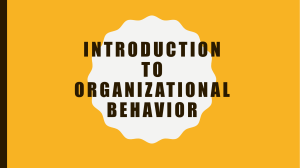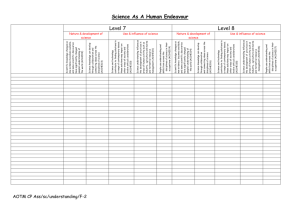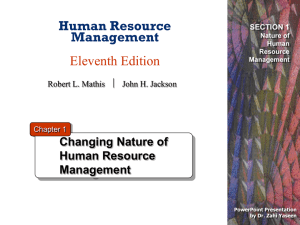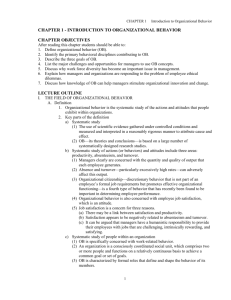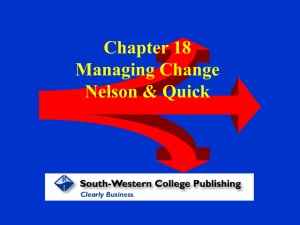Organizational Behavior (OB)
advertisement
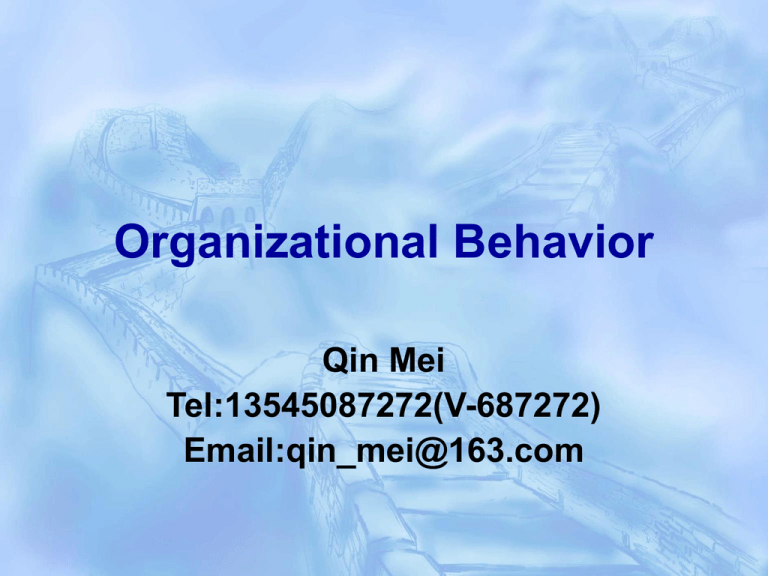
Organizational Behavior Qin Mei Tel:13545087272(V-687272) Email:qin_mei@163.com Chapter 1 Introduction to Organizational Behavior 1.Define organizational behavior(OB) 2.Identify the primary behavioral disciplines contributing to OB 3.Describe the three goals of OB 4.List the major challenges and opportunities for managers to use OB concepts 5.Discuss why workforce diversity has become an important issue in management 6.Discuss how a knowledge of OB can help managers stimulate organizational innovation and change Problems: Bosses’poor communication skills Employees’lack of motivation Conflicts between team members Overcoming employee resistance to a company reorganization Similar concerns Help managers,and potential managers,develop these people skills What Managers Do? A.Management Function: Henri Fayol----Planning Organizing Commanding Coordinating Controlling Today----planning, organizing, leading, controlling B.Management Roles: (Henry Mintzberg) Interpersonal Roles(人际角色) • Figurehead,Leader,Liaison Informational Roles (信息传递者角色) • Monitor,Disseminator,Spokesperson Decisional Roles (决策角色) • Entrepreneur,Disturbance handler, • Resource allocator,Negotiator C.Management Skills: Technical Skills (技术技能) Human Skills (人际技能) Conceptual Skills(概念技能) Effective Versus Successful Managerial Activities Fred Luthans A 1.Traditional management 32% 2.Communication 29% 3.Human resource management 20% 4.Networking 19% S E 13% 19% 28% 44% 11% 26% 48% 11% This finding challenges the historical assumption that promotions are based on performance, and it illustrates the importance of networking and political skills in getting ahead in organizations. Enter Organizational Behavior Organizational Behavior (OB) is a field of study that investigates the impact that individuals, groups, and structure have on behavior within organizations, for the purpose of applying such knowledge toward improving an organization’s effectiveness. It studies three determinants of behavior in organizations: individuals, groups, and structure. In addition, OB applies the knowledge gained about individuals, groups, and the effect of structure on behavior in order to make organizations work more effectively. OB is concerned with the study of what people do in an organization and how their behavior affects the organization’s performance. Specifically with employment-related situations Jobs,work, absenteeism, employment turnover , productivity, human performance, and management The core topics: • • • • • • • • • • Motivation, Leader behavior and power, Interpersonal communication, Group structure and processes, Learning, Attiude development and perception, Change processes, Conflict, Work design, Work stress. Contributing Disciplines Organizational behavior is an applied behavior science that is built on contributions from a number of behavior disciplines. the predominant areas : • • • • • psychology, social psychology, sociology, anthropology, political science Psychology----individual • learning, motivation, personality, emotions, • perception, training, job satisfaction, leadership effectiveness, • individual decision making, performance appraisal, attitude measurement, employee selection, • work design, work stress Social psychology----group • • • • Behavioral change, attitude change, communicate, group processes, group decision making Sociology • Communication, power, conflict, intergroup behavior, ----group • formal organization theory, • organizational technology, • organizational change, • organizational culture ----organization system Anthropology • • • • • • Comparative values, comparative attitudes, cross-culture analysis, ----group organizational culture, Organizational enviroment, Power ----organization system Political science • Conflict, • Intraorganizational politics, ----group • Power ----organization system Goals of OB Explanation • If we are to understand a phenomenon,we must begin by trying to explain it. We can then use this understanding to determine a cause. Prediction • It seeks to determine what outcomes will result from a given action. Control • The control objective is frequently seen by manager as the most valuable contribution the OB makes toward their effectiveness on the job. Challenges and Opportunities for OB 1.Responding to Globalization • • • • Increased foreign assignments Working with people from different cultures Coping with anticapitalism backlash Overseeing movement of jobs to countries with low-cost labor • Managing people during the war on terror 2.Managing workforce diversity • Workforce diversity: Gender, race, national origin, age, disability, • Embracing diversity • Changing demographics Workforce diversity can increase creativity and innovation in organizations as well as improve decision making by providing different perspective on promble. 3.Improving quality and productivity • “Almost all quality improvement comes via simplification of design, manufacturing, layout, processes, and procedures.”----Tom Peters • Today’s managers understand that success of any effort at improving quality and productivity must include their employees. 4.Improving people skills We’ll present relevant concepts and theories that can help you explain and predict the behavior of people at work. • Learn a ways to motivate people • How to be a better communicator • How to create more effective teams 5.Empowering people • Decision making is being pushed down to the operating level, where workers are being given the freedom to make choices about schedules and procedures and to solve work-related problems. • Self-management team • Managers are empowering emplyees. • Managers-how to give up control • Emplyees-how to take responsibility for their work and make appropriate decisions • Leading style, power relationships, the way work is designed, the way organizations are structured 6.Stimulating innovation and change • Today’s successful organizations must foster innovation and master the art of change or they’ll become candidate for extinction. • An organization’s employees can be the impetus for innovation and change or they can be a majors stumbling block. • The challenge for managers is to stimulate their employees’ creativity and tolerance for change. 7.Coping with “temporariness” • Managing today would be more accurately described as long periods of ongoing change, interrupted occasionally by short periods of stability! • The actual jobs that workers perform are in a permanent state of flux. • So workers need to continually update their knowledge and skills to perform new job requirements. 8.Helping employees balance work/life conflicts • A number of forces have contributed to blurring the lines between employee work and personal lives. • First, the creation of global organizations means their world never sleeps. • Second, communication technology allows employee to do their work at home, in their car, or on the beach in Tahiti. • Third, organizations are asking employees to put in longer hours. • Finally, fewer families have only a single breadwinner. 9.Declining employee loyalty • Beginning in the mid-1980s, in response to global competition, unfriendly takeovers, leveraged buyouts, and the like, corporations began to discard traditional policies on job security, seniority and compensation. • An important OB challenge will be for managers to devise ways to motivate workers who feel less committed to their employers, while maintaining their organizations’ global competitiveness. 10.Improving ethical behavior • Members of organizations are increasingly finding themselves facing ethical dilemmas, situations in which they are required to define right and wrong conduct. • In recent years, the line differentiating right from wrong has become even more blurred. • Managers and their organizations are writing and distributing codes of ethics to guide employees through ethical dilemmas. The plan of this book Organization system level Group level Individual level Individual behavior • values, attitudes, perception, and learning • the role of personality and emotions • motivation issues Group behavior • Group behavior model • Ways to make teams more effective • Communication issues and group decision making • Leadership, trust, power, politics, conflict and negotiation Organizational behaviors • Culture, structure, ….
